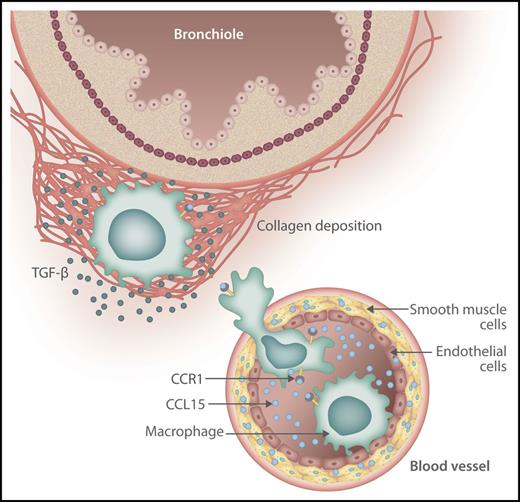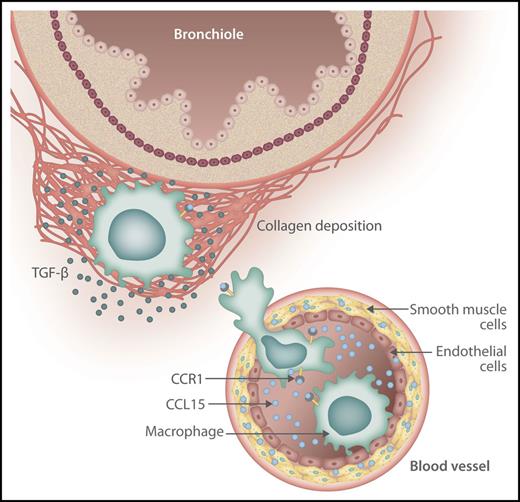In this issue of Blood, Du et al demonstrate that not only is chemokine (C-C motif) ligand 15 (CCL15) a diagnostic and prognostic biomarker in patient samples for chronic graft-versus-host disease (GVHD), but antibody inhibition of its homolog, CCL9, reverses established lung GVHD in a mouse model.1 The median CCL15 concentration was significantly higher in samples from patients with chronic GVHD compared with no chronic-GVHD controls (P = .0125), which may aid in diagnosis. Importantly, CCL15 also had prognostic value. Patients with chronic GVHD who have higher than median CCL15 concentrations were at threefold higher risk for nonrelapse mortality than patients with below median CCL15 concentrations.
Hypothetical model of CCL15 role in chronic lung GVHD. Vascular smooth muscle cells release CCL15 into the blood vessel lumen, where it binds to CCR1 on macrophages. The macrophages then infiltrate the lung tissue where they release TGF-β and induce collagen deposition around the bronchioles. TGF, transforming growth factor. Professional illustration by Somersault18:24.
Hypothetical model of CCL15 role in chronic lung GVHD. Vascular smooth muscle cells release CCL15 into the blood vessel lumen, where it binds to CCR1 on macrophages. The macrophages then infiltrate the lung tissue where they release TGF-β and induce collagen deposition around the bronchioles. TGF, transforming growth factor. Professional illustration by Somersault18:24.
Chronic GVHD is the major cause of late morbidity and mortality following allogeneic hematopoietic cell transplant. Despite its clinical importance, it can be difficult to diagnose, hard to treat, and the underlying biology remains poorly understood. Proteomic biomarkers have helped advance the diagnosis, treatment, and understanding of acute GVHD,2 but only a few chronic GVHD biomarkers, such as soluble B-cell–activating factor, CXCL9, and CXCL10, have been validated.3,4 Recognition of chronic GVHD can be difficult when symptoms are still mild and possibly easier to control.5 It is in this setting that diagnostic and prognostic biomarkers are most likely to prove helpful. However, one of the challenges to developing chronic GVHD biomarkers has been that up to 8 different organs can be symptomatic to varying degrees at any given time and in any combination.5 The investigators of the present study overcame the quandary posed by complicated clinical scenarios by using a reductionist murine model of chronic GVHD to screen for candidate biomarkers. They were able to narrow an initial list of 56 proteins dysregulated in chronic GVHD to 4 lead candidates, which they then measured in human samples. One of these candidates, CCL15, shows promise for diagnosis, assessing prognosis, and as a potential therapeutic target.
CCL15, which is upregulated during inflammation, has several known functions. It stimulates angiogenesis through its interactions with its receptors, CCR1 and CCR3, on endothelial cells.6 In addition, through the same receptors, it functions as a chemoattractant for immune cells, such as monocytes and macrophages, and promotes their adhesion to the endothelium and subsequent migration into the tissue.7 Finally, it induces the production of proinflammatory cytokines through the JAK/STAT pathway.7 CCL15 has been clinically implicated in other inflammatory diseases; for example, elevated CCL15 levels correlate with faster disease progression in pulmonary sarcoidosis, an inflammatory disease of the lung.8 Given what we already know about CCL15, its identification in chronic GVHD is important for several reasons. First, recent studies have established that vascular injury is important in the development of acute GVHD9 and that facilitating vascular repair attenuates GVHD severity.10 In the experimental chronic GVHD model used in this study, CCL9, the relevant murine homolog, was produced by the smooth muscle cells lining the vasculature in the spleen and lung. This new evidence supports the premise that the vasculature is an important driver in chronic GVHD development. The figure shows a hypothetical model based on the data developed in this study and prior studies by this group. Release of CCL15 by the vasculature results in macrophage trafficking and infiltration into the lung, where production of transforming growth factor-β induces collagen deposition around the bronchioles and decreased lung function. Similar processes may take place in other target organs, but the investigators in this study were not able to fully develop confirmatory data for the liver or spleen.
Although antibody blockade of CCL9 did not reverse all manifestations of experimental chronic GVHD and did not affect survival, lung function significantly improved. This finding has important clinical implications. Currently, the main goal of chronic GVHD treatments for the lung is to prevent progression. This work suggests that targeting CCL15 may reverse established disease, which would be of great clinical value. Unfortunately, an inhibitor of CCL15 is not yet available for testing in clinical trials, but perhaps this study may spur its development.
Conflict-of-interest disclosure: J.E.L. is a coinventor of a graft-versus-host disease biomarker patent and receives royalties from Viracor. C.K. declares no competing financial interests.



